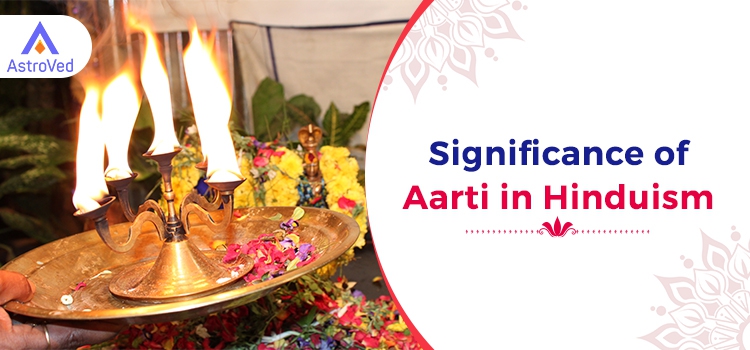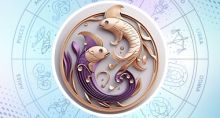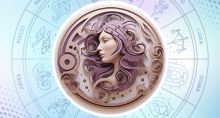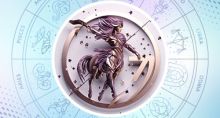Significance of Aarti in Hinduism
What is Aarti?
Aarti is one of the 16 steps (Shodash upachaar) that are part of Hindu rituals like Pooja, Yagna, Homa, etc. It is usually performed at the end of the ritual. When performing Aarti., the worshipper holds a lighted lamp in the right hand and waves the flame in a clockwise, circling movement. This illuminates the entire form of the deity.
While waving the light, the worshipper often prays aloud or in their mind. Or they may merely look at the deity illuminated by the light of the lamp, with devotion. This adds more intensity to the prayers, and the illumined deity appears to radiate with beauty, evoking more bhakti or devotion in the worshipper. At the end of the Aarti, the devotee places their hands over the flame and then gently touches their eyes and the top of their head.
The Skanda Purana says that even if one does not know any Mantras or the correct way to worship, God will accept one’s worship if one performs Aarti with true devotion.

Importance of Performing Aarti
We live in Kaliyug, an epoch of strife, when faith in God is on the wane, with many even doubting the existence of God. In such a spiritually depleted climate, offering Aarti is an easy way for us to realize God. When we offer Aarti, we essentially call out to God with intense longing.
People also chant hymns when performing Aarti. The hymns render praise to the deities and are prayers that ask for divine grace. This pleases the deities, who bestow grace on the one who offers Aarti.
By singing the Aarti, one feels illumined and blessed. The devotee’s spiritual emotion is awakened on account of the activation of the central channel (sushumna nadi) by the words in the Aarti. This awakening of spiritual emotion leads to a spiritual experience, which makes one’s faith in the deity stronger.
As the God principle is more functional during Aarti, the devotee gets more benefit from the energy and Chaitanya (divine consciousness) of the deity. For this reason, being present in a temple during the offering of Aarti is more beneficial than being there at other times.
Why Is Aarti Performed Twice Daily?
Aarti has to be performed both at sunrise and sunset. At sunrise, the raja-tama atmosphere, which is dominantly present during the night is destroyed, and the absolute Fire element frequencies of the divinities arrive in the universe. Hence, Aarti should be offered during sunrise to welcome them.
The 'tarak Chaitanya' or savior form of Chaitanya that is transmitted during the arrival of the frequencies of the deities at sunrise should be welcomed by the devotee through the Aarti, but at sunset, one performs Aarti to destroy the raja-tama frequencies and to invoke the 'marak Chaitanya' or destroyer form of Chaitanya, of the deities. Thus, we perform Aarti twice - at sunrise and sunset.
The Science behind Sunset Aarti
At sunset, the absolute Fire element in the Sun's rays begins to reduce, and the raja-tama particles in the atmosphere begin to increase. The generation of raja-tama frequencies will also increase. Due to this, there will be more negative energies in the environment.
To prevent any harm from this raja-tama environment, we have to invoke the deities through the sound frequencies emitted through the Aarti and bring them into the orbit of the universe. This will increase the proportion of the frequencies of the divinities around us, and the distressing vibrations will reduce. This creates a Kavach or protective armor around our bodies.
Why Do People Wave the Aarti Platter in a Full Circle?
When one offers Aarti using a lamp with five wicks (Pancharti), the platter containing the lit lamp must be waved in a full circle before the deity. This causes a speedy circular movement of sattva frequencies emitted by the lamp’s flame. These sattva frequencies are slowly converted into raja frequencies, appearing like ripples in the water.
These frequencies form a Suraksha Kavach or protective armor around our embodied soul when we offer the Aarti. The more our spiritual emotion, the longer the armor lasts. When our sattva component increases, we can absorb more divine frequencies from around us. This increases our spiritual emotion.
Why Is Camphor Used?
People often use camphor during the Aarti, as it has a spiritual significance. Camphor signifies our vaasanas or inherent tendencies. When it is lit, camphor burns itself completely without a trace. In symbolic terms, this means that all our Vaasanas or materialistic desires are extinguished. Lit by the fire of knowledge, our Vaasanas burn themselves out completely, leaving behind not even a trace of the ego that separates us from God.
The Soul Connection
When we perform the Aarti, our eyes close automatically, and we look within. This means that each devotee is a temple of God, and that divinity resides within us.
When the Aarti concludes, we keep our hands over the flame and then touch our eyes and the top of our head. It means that the light that illumined the deity should light up our vision and that our vision should be divine and our thoughts noble.
Decorating the Aarti Platter
The platter should contain a pot full of water, kumkum, rice, flowers, Dhoop, camphor, bell, clean clothes, and the book of Aarti sangrah. Use the kumkum to make a swastika on the platter. The platter should be a brass or copper one.
Rules for Aarti
- One should offer prayers, chant, or sing Bhajans when offering Aarti.
- Perform Aarti when the Pooja or ritual ends.
- If you use a diya, it should be Panchmukhi (with 5 faces).
- Always keep flowers and kumkum.
- Move the platter in such a way that it forms ‘Om’ (the Hindi word).
- Move the platter near the deity’s feet 4 times, navel twice, once in front of the face, and 7 times around the deity’s entire body.
- After the Aarti, offer flowers to the deity and put a tilak on the deity’s face with some kumkum.




















